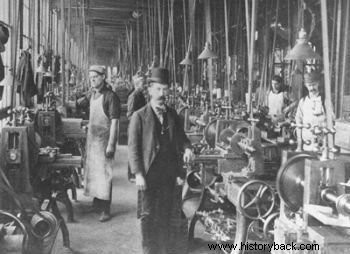The First Industrial Revolution was generated by the Commercial Revolution that took place in Europe between the 15th and the mid-18th century.
The expansion of international trade and the increase in wealth allowed the financing of technical progress and the installation of industries.
Industrial Revolution in England
 Factory Workers
Factory Workers
The First Industrial Revolution began in England around 1750, and soon reached France, Belgium, and later Italy, Germany, Russia, Japan, and the United States. At that time, commercial activities commanded the pace of production.
In the English industrial revolution, the main manufacture was wool weaving. But it was in the production of cotton fabrics that the mechanization process began, that is, the transition from manufacturing to the manufacturing system.
The raw material came from the colonies (India and the United States). About 90% of English cotton fabrics were sold abroad, which played a decisive role in England's industrial boom.
Mechanization and Inventions
Mechanization extended from the textile sector to metallurgy, transport, agriculture and other sectors of the economy. Several inventions revolutionized production techniques and altered the system of economic power.
The great source of wealth shifted from commercial to industrial activity. Whoever developed the ability to produce goods would become the world's economic leader.
And that's what happened to England, being the first country to industrialize using the machine in production:
- the spinning machine , which transforms cotton, silk and wool textile fibers into yarn for the manufacture of fabrics. This invention revolutionized the production technique, transforming England into the largest producer of yarn for fabrics. This invention replaced the distaff, one of the simplest and oldest spinning instruments.
- the power loom , invented in 1785, replacing the manual loom, considerably increased the production of fabrics, placing England in the world leadership at the time.
- the steam engine , whose use in the textile industry, coal plants, iron industrialization, vessels (steam ships), railroads (steam locomotive), among others, represented a revolution in the transport of passengers and cargo.
The invention of machines, the use of the heat energy from mineral coal and its transformation into mechanical energy to make the machines work, represented a great advance in the techniques used to manufacture goods and, consequently, in the increase of production.
England thus passed from manufacturing for machinemaking . It produced and sold its industrial products all over the world, thanks, among other factors, to the expansion of the colonial system.
Thus, in the 18th century, the country became the largest capitalized nation in the world, with London being the international financial capital.
This moment represented a real revolution in the way of producing goods in a much shorter time, compared to manufacturing.
The early development of mechanized textile industries in much of Europe and the United States depended on many of these British inventions. This revolution became known as the First Industrial Revolution.
Industrial Revolution - All MatterWant to know more about the topic? Also Read :
- Industrial Revolution
- Second Industrial Revolution
- Third Industrial Revolution
- Phases of the Industrial Revolution
- Causes of the Industrial Revolution
- Consequences of the Industrial Revolution
- Questions about the Industrial Revolution
